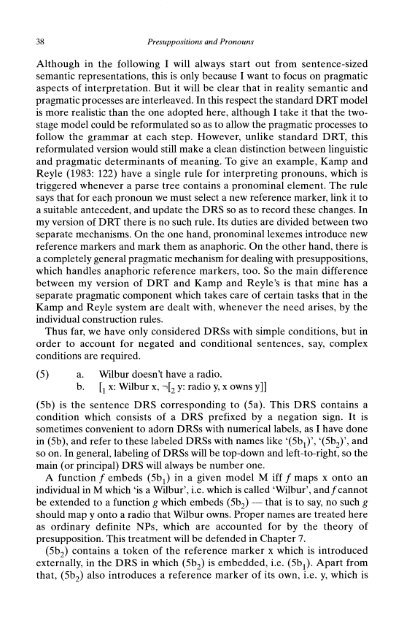Presuppositions and Pronouns - Nijmegen Centre for Semantics
Presuppositions and Pronouns - Nijmegen Centre for Semantics
Presuppositions and Pronouns - Nijmegen Centre for Semantics
Create successful ePaper yourself
Turn your PDF publications into a flip-book with our unique Google optimized e-Paper software.
38 <strong>Presuppositions</strong> <strong>and</strong> <strong>Pronouns</strong><br />
Although in the following I will always start out from sentence-sized<br />
semantic representations, this is only because I want to focus on pragmatic<br />
aspects of interpretation. But it will be clear that in reality semantic <strong>and</strong><br />
pragmatic processes are interleaved. In this respect the st<strong>and</strong>ard DRT model<br />
is more realistic than the one adopted here, although I take it that the two-<br />
twostage<br />
model could be re<strong>for</strong>mulated so as to allow the pragmatic processes to<br />
follow the grammar at each step. However, unlike st<strong>and</strong>ard DRT, this<br />
re<strong>for</strong>mulated version would still make a clean distinction between linguistic<br />
<strong>and</strong> pragmatic determinants of meaning. To give an example, Kamp <strong>and</strong><br />
Reyle (1983: 122) have a single rule <strong>for</strong> interpreting pronouns, which is<br />
triggered whenever a parse tree contains a pronominal element. The rule<br />
says that <strong>for</strong> each pronoun we must select a new reference marker, link it to<br />
a suitable antecedent, <strong>and</strong> update the DRS so as to record these changes. In<br />
my version of DRT there is no such rule. Its duties are divided between two<br />
separate mechanisms. On the one h<strong>and</strong>, pronominallexemes lexemes introduce new<br />
reference markers <strong>and</strong> mark them as anaphoric. On the other h<strong>and</strong>, there is<br />
a completely general pragmatic mechanism <strong>for</strong> dealing with presuppositions,<br />
which h<strong>and</strong>les anaphoric reference markers, too. So the main difference<br />
between my version of DRT <strong>and</strong> Kamp <strong>and</strong> Reyle's is that mine has a<br />
separate pragmatic component which takes care of certain tasks that in the<br />
Kamp <strong>and</strong> Reyle system are dealt with, whenever the need arises, by the<br />
individual construction rules.<br />
Thus far, we have only considered DRSs with simple conditions, but in<br />
order to account <strong>for</strong> negated <strong>and</strong> conditional sentences, say, complex<br />
conditions are required.<br />
(5) a. Wilbur doesn't have a radio.<br />
b. [j x: Wilbur x, ->[ 2 y: radio y, x owns y]]<br />
b. h x: Wilbur x, 'b y: radio y, x owns y]]<br />
(5b) is the sentence DRS corresponding to (5a). This DRS contains a<br />
condition which consists of a DRS prefixed by a negation sign. It is<br />
sometimes convenient to adorn DRSs with numerical labels, as I have done<br />
in (5b), <strong>and</strong> refer to these labeled DRSs with names like '(5b '(5^)', 1<br />
)" '(5b 2 )', <strong>and</strong><br />
so on. In general, labeling of DRSs will be top-down <strong>and</strong> left-to-right, so the<br />
main (or principal) DRS will always be number one.<br />
A function f / embeds (5b^ 1<br />
) in a given model M iff f / maps x onto an<br />
individual in M which 'is a Wilbur', i.e. which is called 'Wilbur', <strong>and</strong>/cannot f be extended to a function g which embeds (5b 2 ) -— that is to say, no such g<br />
should map y onto a radio that Wilbur owns. Proper names are treated here<br />
as ordinary definite NPs, which are accounted <strong>for</strong> by the theory of<br />
presupposition. This treatment will be defended in Chapter 7.<br />
(5b 2 ) contains a token of the reference marker x which is introduced<br />
externally, in the DRS in which (5b 2 ) is embedded, i.e. (5b 1 ). Apart from<br />
that, (5b 2 ) also introduces a reference marker of its own, i.e. y, which is














